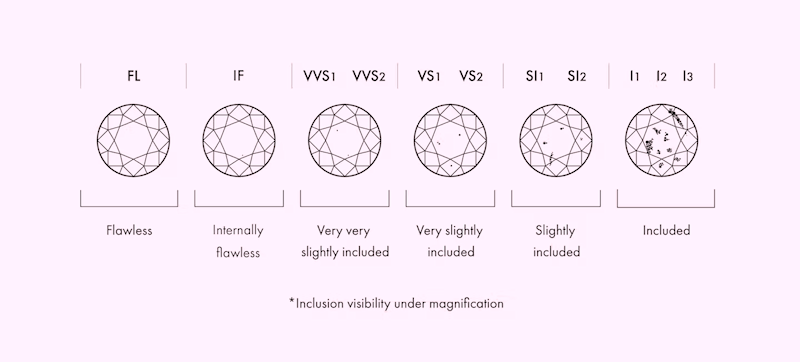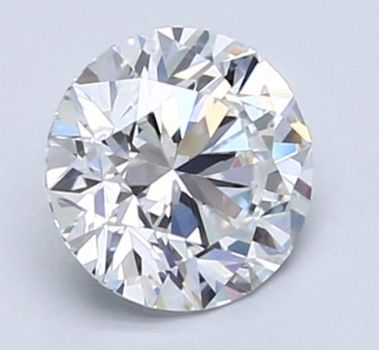
Flawless Diamonds Are The Rarest Of All In Terms Of Clarity
Flawless clarity, also known as “FL,” is the highest grade of clarity in the diamond grading scale. This means that the diamond has no internal or external flaws or imperfections, and is considered to be of the highest possible quality.
It is important to note that even diamonds that are graded as “flawless” will have some level of inclusions when viewed under high magnification. While these inclusions may be too small or difficult to see with the naked eye, they can still be present within the diamond.
So please keep in mind that when we refer to “flawless”, we use the ability to see any inclusions under 10x magnification as the criteria for spotting visibility.
Diamonds are graded for clarity by trained gemologists using a set of standardized criteria. The criteria include the number, size, location, and nature of any inclusions or blemishes within the diamond. Inclusions are internal defects, such as cracks or fractures, while blemishes are external imperfections, such as scratches or chips.

Above is a picture example of a Flawless grade diamond
Flawless clarity diamonds are extremely rare and highly sought after because of their exceptional quality. In order to achieve this grade, a diamond must be free of any inclusions or blemishes that can be seen under 10x magnification. This level of perfection is very difficult to achieve, and only a small percentage of diamonds meet these standards.

The presence of inclusions or blemishes can affect the overall quality and value of a diamond. Inclusions can interfere with the diamond’s ability to reflect light, reducing its sparkle and brilliance. Blemishes can also alter the diamond’s appearance, making it look dull or unappealing.
In Terms Of Clarity Grade, It’s The Best One Can Get
In general, the higher the clarity grade of a diamond, the more valuable it will be. Flawless clarity diamonds are considered to be the most valuable and desirable of all, as they offer the maximum amount of sparkle and brilliance. However, they can also be very expensive, as they are so rare.
When shopping for a diamond, it is important to consider the clarity grade along with the other factors of the diamond’s quality, such as carat weight, cut, and color. A diamond with flawless clarity may be more expensive, but it will also be of the highest possible quality and offer the most sparkle and brilliance.
5 Reasons To Choose Flawless Diamonds
- Flawless diamonds have a higher resale value. Because they are considered the highest quality in terms of clarity, they are more sought after by buyers and therefore command a higher price on the resale market.
- Flawless diamonds are more rare. Because diamonds with high clarity are less common, owning a flawless diamond can be seen as a status symbol.
- Flawless diamonds have better optical properties. Because they do not have inclusions or blemishes, flawless diamonds allow light to pass through them more easily, resulting in a higher level of brilliance and sparkle.
- Flawless diamonds are more durable. Inclusions and blemishes can act as points of weakness in a diamond, making it more susceptible to chipping or breaking. Because flawless diamonds do not have these weaknesses, they are generally more durable and less likely to be damaged.
- Flawless diamonds are more aesthetically pleasing. Because they do not have any visible inclusions or blemishes, flawless diamonds have a clean, pure appearance that is highly desirable to many people. This makes them more pleasing to the eye and can enhance the overall beauty of a piece of jewelry.
6 Things To Keep In Mind When Buying Flawless Diamonds
- Consider the price. Because flawless diamonds are the highest quality in terms of clarity, they are also often the most expensive. It is important to have a budget in mind and to compare prices from different vendors to ensure that you are getting the best value for your money.
- Look for certification. In order for a diamond to be considered flawless, it must be certified by a reputable independent laboratory, such as the Gemological Institute of America (GIA) or the International Gemological Institute (IGI). It is important to look for this certification when purchasing a flawless diamond, as it provides assurance that the diamond has been thoroughly evaluated and meets the highest standards of clarity.
- Consider the cut. The cut of a diamond refers to its proportions and symmetry, which can affect the diamond’s sparkle and brilliance. Flawless diamonds should have a well-cut, symmetrical shape to maximize their optical properties and create a stunning visual effect.
- Consider the setting. The setting of a diamond can also affect its appearance and overall value. A well-made setting can enhance the beauty of a flawless diamond, while a poorly made setting can detract from it. It is important to carefully consider the setting and choose one that will complement the diamond and enhance its overall beauty.
- Shop around. Because flawless diamonds are a significant investment, it is important to shop around and compare prices and options from different vendors. This will help you to make an informed decision and ensure that you are getting the best value for your money. Additionally, working with a reputable jeweler who has experience with flawless diamonds can provide valuable advice and guidance throughout the buying process.
- While there is a distinction between “flawless” and “internally flawless” diamonds, it is important to note that the clarity of these two grades is almost exactly the same. This is because the inclusions that are present in internally flawless diamonds are usually so small or difficult to see that they do not significantly impact the appearance or value of the diamond.
One of the main reasons why flawless diamonds are a good choice for value preservation is because they are so rare. Because there are so few flawless diamonds in existence, they tend to be highly prized and in high demand. Another reason why flawless diamonds are a good choice for value preservation is because they are considered to be of such high quality.
The Distinction Between “Flawless” and “Internally Flawless”
The distinction between “flawless” and “internally flawless” diamonds is based on the location of the inclusions or blemishes. Inclusions that are located within the body of the diamond (internally) are not visible to the naked eye and do not impact the clarity grade of the diamond. However, blemishes that are present on the surface of the diamond (externally) are visible to the naked eye and can affect the clarity grade of the diamond.